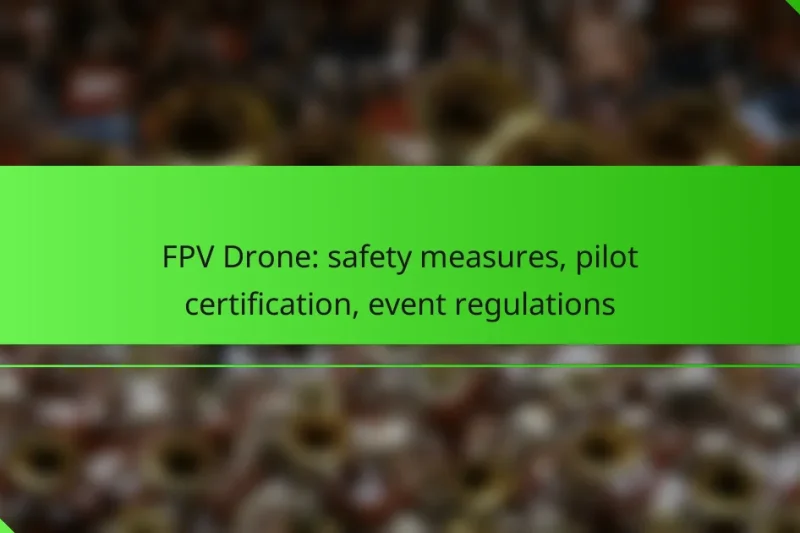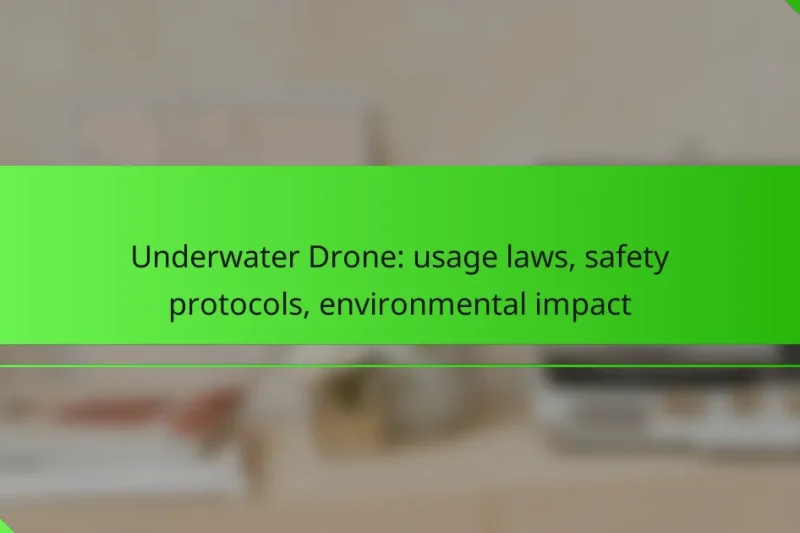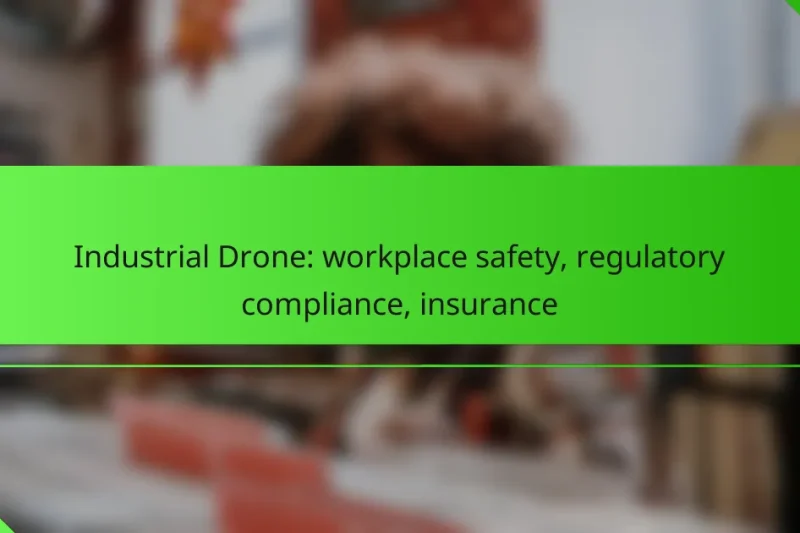FPV drone operation requires adherence to essential safety measures, including pre-flight checks and regular equipment maintenance, … FPV Drone: safety measures, pilot certification, event regulationsRead more
Understanding Drone Regulations and Safety
Understanding drone regulations and safety is essential for both recreational and commercial operators. In the United States, the Federal Aviation Administration (FAA) sets the primary guidelines, which are complemented by state and local laws. Adhering to these regulations not only ensures legal compliance but also promotes safe flying practices, such as conducting pre-flight checks and respecting altitude limits.
Underwater Drone: usage laws, safety protocols, environmental impact
Underwater drones are becoming increasingly popular for various applications, but their usage is governed by a … Underwater Drone: usage laws, safety protocols, environmental impactRead more
Industrial Drone: workplace safety, regulatory compliance, insurance
Industrial drones play a crucial role in enhancing workplace safety by minimizing human exposure to hazardous … Industrial Drone: workplace safety, regulatory compliance, insuranceRead more
What are the key drone regulations in the United States?
The key drone regulations in the United States primarily involve guidelines set by the Federal Aviation Administration (FAA), along with various state-specific laws and local ordinances. Understanding these regulations is crucial for safe and legal drone operation.
Federal Aviation Administration (FAA) guidelines
The FAA regulates drone operations through a set of rules that apply nationwide. These guidelines include requirements for registration, restrictions on flying near airports, and altitude limits, typically capped at 400 feet above ground level for recreational users.
Additionally, drone operators must maintain visual line of sight with their aircraft and avoid flying over people or moving vehicles. For commercial use, obtaining a Part 107 certification is necessary, which involves passing a knowledge test on airspace regulations and safety protocols.
State-specific laws
Each state may impose its own regulations regarding drone use, which can vary significantly. For example, some states have laws that prohibit flying drones over private property without permission, while others may have specific restrictions related to wildlife protection or emergency response areas.
It’s essential to research your state’s drone laws before flying. Websites like the National Conference of State Legislatures provide updated information on state-specific regulations, helping operators stay compliant.
Local ordinances
Local governments can enact ordinances that further regulate drone use within their jurisdictions. These may include restrictions on flying in certain parks, residential areas, or near schools and hospitals. Local laws can be more stringent than state or federal regulations.
To avoid fines or legal issues, check with local authorities or municipal websites for any drone-related ordinances. Engaging with local drone clubs or online forums can also provide insights into community-specific rules and best practices.
How to register a drone for commercial use?
To register a drone for commercial use, you must complete the registration process through the appropriate aviation authority in your country. This typically involves filling out an online form and paying a registration fee.
Online registration process
The online registration process usually begins by visiting the website of your country’s aviation authority. For example, in the United States, you would go to the Federal Aviation Administration (FAA) website to access the registration portal.
Once there, you will need to create an account or log in if you already have one. Follow the prompts to enter your drone’s details, including its make, model, and serial number.
Required documentation
<pWhen registering a drone for commercial use, you typically need to provide specific documentation. This may include proof of identity, such as a government-issued ID, and details about your business if applicable.
In some cases, you may also need to submit a copy of your drone’s insurance policy or any relevant certifications, particularly if your drone is used for specialized tasks like aerial photography or surveying.
Registration fees
Registration fees for commercial drones can vary widely depending on the country and the type of drone. In the U.S., for instance, the fee is generally around $5 for a three-year registration.
Be sure to check the specific fee structure on your aviation authority’s website, as some countries may have different pricing tiers based on the drone’s weight or intended use.
What are the safety requirements for flying drones?
Safety requirements for flying drones include conducting thorough pre-flight checks, adhering to altitude restrictions, and maintaining awareness of airspace regulations. These practices help ensure safe operations and compliance with local laws.
Pre-flight checks
Before flying a drone, operators should perform a series of pre-flight checks to ensure the equipment is in good working condition. This includes inspecting the drone for any physical damage, checking battery levels, and ensuring that all components are functioning properly.
Additionally, it is advisable to verify that the drone’s software is up to date and that the GPS signal is strong. A checklist can be helpful to ensure that no steps are overlooked, enhancing safety during the flight.
Altitude restrictions
Most regions impose altitude restrictions on drone flights, typically limiting operations to a maximum of 120 meters (400 feet) above ground level. This limit helps prevent collisions with manned aircraft and ensures safer airspace management.
Operators should always check local regulations, as some areas may have lower altitude limits, especially near airports or populated zones. Understanding these restrictions is crucial for compliance and safety.
Airspace awareness
Being aware of the airspace in which you are flying is essential for drone safety. Different airspace classifications have specific rules regarding drone operations, particularly near airports and restricted zones.
Drone pilots should familiarize themselves with local airspace maps and use apps that provide real-time information on airspace status. Avoiding restricted areas and understanding temporary flight restrictions can prevent legal issues and enhance safety during flights.
What are the penalties for violating drone regulations?
Violating drone regulations can lead to significant penalties, including fines and potential criminal charges. The severity of these penalties often depends on the nature of the violation and the jurisdiction in which it occurs.
Fines and legal repercussions
Fines for drone regulation violations can vary widely, typically ranging from a few hundred to several thousand USD. For instance, flying in restricted airspace or without proper registration may incur fines from local aviation authorities.
In some cases, repeated violations can lead to increased fines or additional legal actions. It’s essential for drone operators to stay informed about local regulations to avoid these financial penalties.
Potential criminal charges
Serious violations of drone regulations can result in criminal charges, including reckless endangerment or invasion of privacy. Depending on the severity, these charges can lead to misdemeanor or felony classifications.
For example, using a drone to capture images in private areas without consent may lead to criminal prosecution. Operators should understand that certain actions can have legal consequences beyond just fines.
Impact on future drone use
Violating drone regulations can severely impact an individual’s ability to operate drones in the future. Authorities may revoke licenses or impose restrictions on future drone activities.
Additionally, a history of violations can affect insurance rates and eligibility for drone-related services. Maintaining compliance with regulations is crucial for sustaining future drone operations and avoiding long-term repercussions.
How to choose a drone that complies with regulations?
To choose a drone that complies with regulations, start by understanding the specific laws in your country or region. Look for drones that are designed to meet these legal requirements, which often include weight limits, operational altitudes, and safety features.
Certification labels
Certification labels indicate that a drone meets certain safety and regulatory standards. In the United States, for instance, look for drones that have been certified by the Federal Aviation Administration (FAA) or other recognized bodies. In Europe, ensure the drone complies with European Union Aviation Safety Agency (EASA) regulations.
When selecting a drone, check for labels like the ASTM F3150 for small unmanned aircraft systems. These labels can help you assess the drone’s reliability and adherence to safety protocols.
Manufacturer compliance
Manufacturer compliance is crucial for ensuring that the drone you choose adheres to local regulations. Reputable manufacturers often provide documentation that outlines how their drones meet regulatory requirements. This includes information on weight, flight capabilities, and safety features.
Before purchasing, research the manufacturer’s reputation and their history of compliance with regulations. Look for user reviews and feedback on how well the drone performs in real-world conditions, as this can provide insights into its reliability and safety.


